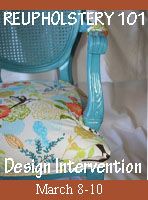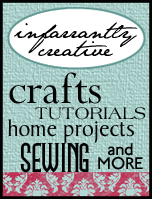Alright - - are you ready for day 3? Click on these links if you missed Day 1 or Day 2.
After yesterday, we had the back and seat base of our chair done. Today we are going to tackle the arms. Honestly, as far as the actual chair (not the cushion) this is the hardest part. So, hopefully I can clear up some confusion on how to tackle these!
Today it is going to be super important to refer back to the photos you took as you were taking the fabric off your chair. I make sure that I mark directly on my old fabric where the cording is sewn to your fabric (around the front of your arm from the inside bottom of your chair around the top of the arm ending under the curve of the arm) and where the fabric is sewn together (from the point where your inside arm meets the seat base around the top ending under the curve of the arm).
Let’s start by taking your piece of fabric that you cut for the front of your arm and placing it on the front (I usually use long straight pins to hold it in place). Using your piece of chalk, mark the shape of the arm directly on your piece of fabric. This is going to be the line that you will follow when you sew your welting on. Make sure that you mark on your fabric where you need to start and stop sewing your welting. You are going to have a long tail of welting that is not attached on the outside edge
Next you are going to attach your fabric to the front panel by sewing the piece of fabric you have cut to cover over the top hump of your arm with the welting sandwiched between the arm front panel and the arm top panel. Again, this is not going to attach the entire way around.
Make sure you mark where you need to start and stop (starting under the arm - - - with about 3 inches of overlap hanging free and finishing on the inside of the arm right where the arm meets the seat support - - again leaving about 8 inches of overlap hanging free) This is all going to be sewn together.
Once you have the top of the arm sewn together, it’s time to put it on your chair. Place the fabric over the arm making sure it is a perfect snug fit. If you need to make adjustments, now is the time! Where the top of the arm meets the back of your chair, this is going to tuck in to a small gap in the frame where you will eventually staple it. After this is perfect, you are going to begin stapling. You are going to staple the front of your arm first. Lift up the front fabric and squeeze your staple gun to the inside edge of your fabric (where your welting is attached) staple along this line.
Now, we need to staple the front outside edge. Pull this fabric smooth and staple it around the corner. You are going to have your piece of welting hanging free. 
Next we are going to staple the fabric under the curve of the arm. Make sure you smooth your fabric over the arm as you go. There is a wooden support that runs right under the arm - -this is where you will staple the fabric.
Next you want to take care of the inside of the arm. This fabric will tuck in a gap between the inside arm and the seat base. You will staple this to the outside arm frame - - right on top of where you stapled your seat base fabric. You can see the cushion sticking out in the picture above, your fabric is going to tuck in right behind that and staple on the frame below it!
The last part of this that we need to attach is the back of the arm. Again, refer back to your pictures to see if this has been smoothly attached or if pleats have been folded and stapled. On my chair, there were lots of pleating to make it a smooth fit around the curve of the chair. Once you have made your pleats, go ahead and staple it down.
Whew! Now all you have to do is the other arm!!!
Next, it’s time to move on to the panel under the arm. This is a fairly easy piece to do, so let’s get started!!
Take your new piece of fabric and place it over the under arm panel. Keeping a 3”-4” clearance of fabric at the top. Once you are sure of the placement, you are going to fold this piece up, but making sure that you keep the top portion exactly in place. 
I don’t know what the technical name for this cardboard ribbon is, but it’s a life saver! You can find it in the re-upholstery section of any fabric store. It comes in a fairly large roll - - I’ve had mine for almost 2 years and I have done a lot of furniture!! 
You are going to lay this right under the arm on top of the wrong side of your lower panel fabric. Staple right along this line with plenty of staples! This is going to give a clean crisp edge under your arm and give it some stability.
Next, we need to attach the front of the panel. You should have a piece of welting that is not attached along the outside of your arm. Now is the time to attach it. You are going to lay it smoothly along the edge and staple it down.
Curve-ease Ply Grip is absolutely the best stuff in the world!! It is a re-upholsterers best friend! 
Attach curve-ease with staples right in tight next to your welting.
Then fold the curve-ease down so that there is just a 1/4” gap
Mark the line where the curve-ease is with chalk .
Then trim your fabric to about 1/2” of your chalk line. 
Tuck your fabric in the curve ease using a tine flathead screw driver or an ice pick. 
After you have your fabric tucked it, it’s time to pound it down flat with your hammer. 
All you have left to do now is fold your fabric around the back of your chair and staple it down, then pull the fabric tight on the bottom of your chair and staple.
And now, if you have stuck with me through all of this, you deserve a very big prize!! I exhausted just from writing this and I really hope that it makes sense!! Join me tomorrow as we finish up the rest of the chair. All we have left is the back and the cushion!!




































6 comments:
You have done a fantastic job on this chair and an equally fantastic job of explaining it! I am wondering if that sticking plaster on your finger is courtesy of an upholstery mishap. I usually end up with one or two at the end of a project, more often than not it's from removing stubborn staples.
Really enjoying your blog.
Angex
I got lost with the whole arm thing :-(
I bow before you Wise One!! You have shared so many great *secrets*. I am loving your blog.
Wow, I feel totally lost on this one. I think it's going to have to take having a chair right in front of me and following along your instructions.
That curve ease is very cool stuff! (Did I already say that on another post?) Wish I would have had some when I did Adam's chair...I have another chair I'm thinking about doing...maybe I'll order some!
And, just so you don't think I'm a total loser sitting at home reading every one of your blog posts on NYE, we're stuck at home in an ice storm and hubby has been playing with my son. As soon as he's in bed we have a movie planned. :)
Your tutorials are great in general but perhaps it would be easier to see the process if you had used a plain fabric instead of a dark print. I know you were doing your own chair but the photos are really hard to see.
Post a Comment